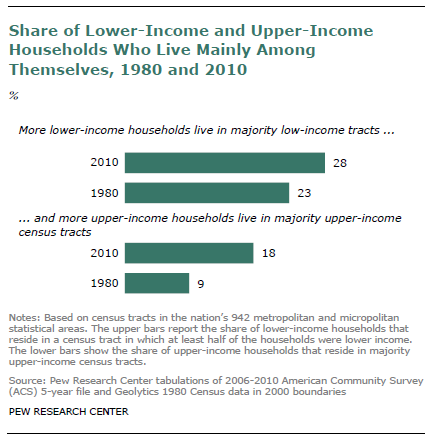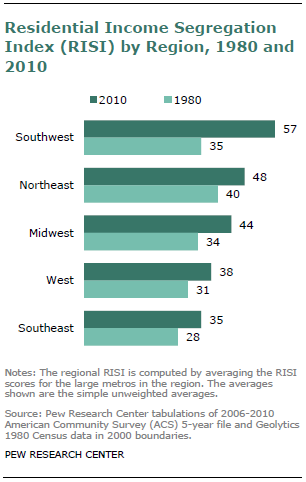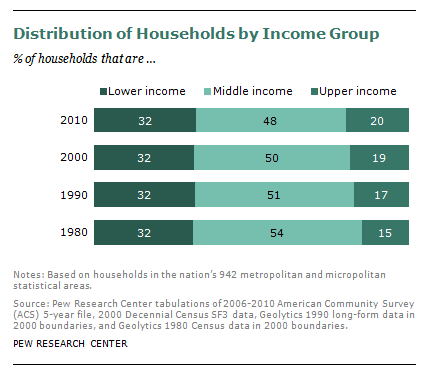When we talk about residential segregation, we’re generally focusing on race, and for good reason — many cities in the U.S. still have incredibly high rates of racial segregation. However, a recent Pew Research Center report looks at economic segregation, which is increasing in U.S. neighborhoods.
Economic segregation refers to the degree to which people in different social classes live mostly among other people of their class. In 2010, the majority (76%) of people in the U.S. lived in middle-class or mixed-income neighborhoods. But economic segregation has increased in the last few decades. More of both lower-income and upper-income households live in Census tracts made up of households primarily like themselves:
The RISI index for a city just combines the % of both groups that live in tracts dominated by their own income group (so the maximum score is 200). Looking at RISI scores by region, we see that the Southwest has the most economic segregation, and has increased more than any other region in the past 30 years:
The Pew report argues that this is related to the general increase in income inequality, with less than half of the U.S. population falling into the middle class by 2010, and the upper class (here defined as those making more than $104,000) increasing:
Economic segregation is still a less prominent feature of cities than racial segregation is. But given its steady increase, it’s worth thinking about the consequences of the relative isolation of different social classes from one another. When the rich, poor, and middle-income groups live in different parts of town, who will have the political influence to draw municipal spending to their neighborhoods? How will this growing residential pattern affect who has access to nice parks, public facilities such as libraries and recreation centers, and maintenance for schools and roads — or, alternatively, whose neighborhoods become the location for generally undesirable or unpleasant industries or land uses?




Comments 9
Daisy — August 6, 2012
How is middle class income defined for these charts?
Yrro Simyarin — August 6, 2012
Wonder if there's a link to the rise of Homeowners' Associations.
ECONOMIC SEGREGATION IN U.S. NEIGHBORHOODS « Welcome to the Doctor's Office — August 6, 2012
[...] from SocImages [...]
50 Years Later, A Dream Deferred | Change From Within — August 28, 2013
[...] face the manacles of segregation and the chains of discrimination. Our communities are becoming ever more economically segregated, and so long as people of Color remain disproportionately poor, we ensure that King’s dream [...]
Bob v — November 2, 2014
As more people appreciate diversity feel comfortable living in mixed areas, the affect is prices go up for housing; a higher income group is competing for the same properties. The other result is the sellers who may be minorities obtain financial freedom when they sell.